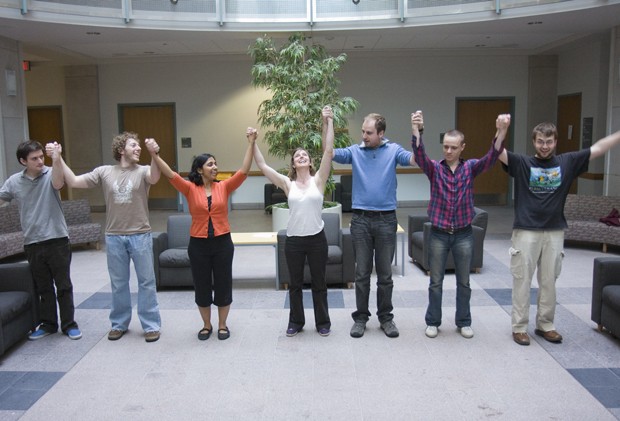Dancing to volcanic booms and even a hoedown, doctoral candidates and professors did something very unusual Friday evening: They performed interpretive dances of their dissertations. âÄúGonzo ScientistâÄù John Bohannon, writer for the academic journal âÄúScience,âÄù launched a workshop for the 2010 Dance Your Ph.D. competition at the University of Minnesota for doctoral candidates and professors who were interested in creating interpretive dances from their dissertations. Bohannon first posed the challenge to scientists in Vienna, Austria in 2007, where the interpretive dances were performed at a live event. However, in 2009 the Dance Your Ph.D. contest was done entirely online. He never thought the contest would take off like it did, he said. What started out as âÄúa drunken party stuntâÄù turned into a YouTube contest where contestants upload their dance and a panel of scientists and dancers judge the submissions based on scientific and artistic merit and creativity, Bohannon said. âÄúThey are hilarious and sometimes beautiful,âÄù Bohannon said. âÄúNot only are they fun to watch, but you canâÄôt help but learn science from a five-minute experience.âÄù The only requirements to participate are that the doctoral or post-doctoral candidates or Ph.D. professors must be in a scientific field and be a performer in the dance, Bohannon said. The dances can last a maximum of 10 minutes, but the best are generally one to two minutes, Bohannon said. Each group had an hour to explain their thesis to their group and then work together to turn it into a dance. At the end of the workshop, the groups presented their dance to Bohannon, who taped them and provided feedback for improvement. Biomedical engineering professor David Odde invited Bohannon to come out and host the workshop at the University. Odde is participating in his first Dance Your Ph.D. contest simply because he thought it would be a lot of fun. Odde and University theater arts and dance professor Carl Flink have been collaborating on a project called âÄúChoreography of the Moving Cell: Self-organization and CatastropheâÄù using body movements to depict cellular processes. âÄúWeâÄôve been thinking about this stuff already, and itâÄôs been really fun,âÄù Odde said. Alvina Kittur, a 29-year-old sixth-year cognitive and biological psychology doctoral candidate, is studying the effects of meditation on emotional attention memory, and she is preparing a dance that will mimic emotional expression with a fun twist. âÄúI really love dancing,âÄù Kittur said, âÄúso I always wanted an artistic outlet for my work.âÄù Kittur and her group performed a dance featuring a team of battling robots and âÄúexpressers,âÄù which is supposed to represent how memory performance affects people who witness a disturbing image. âÄúI thought it was hilarious,âÄù Kittur said. Professor Steven McLoon of the department of neuroscience came out for support, but he did not perform in his groupâÄôs interpretive dance, which used hands to represent the results of his retinal development studies. Dan King, a 29-year-old fourth-year doctoral candidate, presented his geophysics dissertation by dancing to volcanic booms. He heard about the contest a year ago and decided to try it. âÄúI thought it would be a fun way to do something fun with my non-science friends,âÄù King said. Thirty-year-old fifth-year doctoral student Anna Henderson and her group performed a hoedown incorporating traditional folk dancing and square dancing to portray her geology and geophysics thesis on the seasonal distribution of precipitation on ecosystems. The official starting dates for the 2010 event have not yet been announced by Science, but Bohannon said the deadline for submitting entries is Aug. 1. This year there will be cash prizes for the winners and a chance to have their dance screened at the Imagine Science Film Festival in New York in October, Bohannon said, though the bizarreness of the dancing alone should be all the incentive the participants need, he added.

Image by Aleutian Calabay
Nick Leddy
Students dance their dissertations
A workshop taught students to turn dissertations into interpretive dances.
Published April 25, 2010
0

